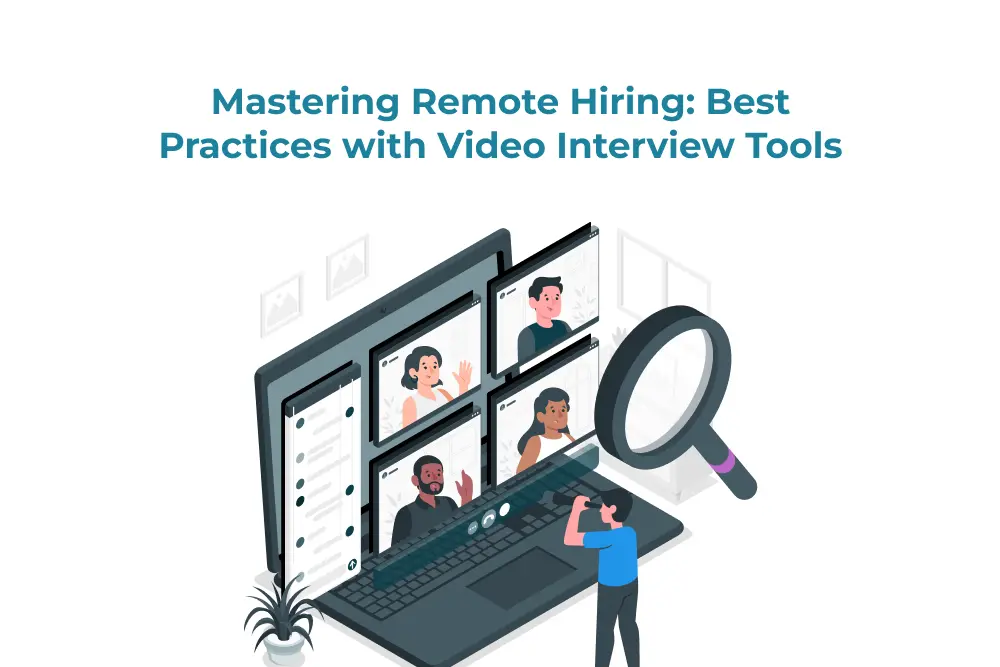Remote hiring has grown to be a crucial procedure for businesses looking to entice top talent from across the world in today’s dynamic job market. Video interviewing technologies have become an important resource for hiring managers and recruiters as a result of technological advancements. In this post, we’ll examine the advantages of remote hiring and look at the best practices that can assist businesses in becoming experts at using video interviewing technologies to find the finest candidates.
Introduction to remote hiring
Remote hiring, also known as virtual hiring or telecommuting hiring, refers to the process of recruiting and onboarding employees who will be working remotely rather than in a traditional office setting. This practice has gained popularity in recent years as it allows companies to tap into a global talent pool and build diverse teams.

Remote hiring offers numerous advantages for both employers and candidates. Companies can save on costs associated with office space, while candidates have the flexibility to work from anywhere, eliminating the need for relocation. Additionally, the ability to work remotely has become particularly appealing to millennials and Gen Z, who priorities work-life balance and value the freedom to design their own work environment.
Access to a larger talent pool is one of the main advantages of remote hiring. Geographical restrictions can be lifted, allowing businesses to recruit and hire top personnel from all over the world. This gives companies the chance to hire workers from a variety of backgrounds, experiences, and viewpoints. The international aspect of remote recruiting also encourages cross-cultural interaction and develops a more welcoming workplace.
The cost savings associated with not having a real office space are another benefit of remote hiring. Traditional office arrangements necessitate hefty rent, utility, and upkeep payments. Companies can use these revenues for other parts of their organization, such as staff development, technological infrastructure, or extending their product offerings, by implementing remote recruiting techniques.
For candidates, remote hiring offers a level of flexibility and freedom that is highly valued in today’s workforce. The ability to work from anywhere eliminates the need for long commutes or relocation, allowing individuals to find a better work-life balance. This flexibility is particularly attractive to millennials and Gen Z, who priorities experiences and personal growth over a traditional nine-to-five office job.
In addition to work-life balance, remote hiring also allows employees to design their own work environment. Some individuals thrive in a quiet and focused home office, while others prefer the hustle and bustle of a coffee shop. Remote work empowers employees to choose the setting that best suits their productivity and creativity. This autonomy can lead to increased job satisfaction and overall well-being.
Remote employment does, however, provide a unique set of difficulties. When team members are dispersed across various time zones and locales, communication and collaboration may be more challenging. To make sure that remote teams remain connected and cohesive, employers need to make investments in efficient communication tools and procedures. As they miss out on the social contacts and camaraderie that come with working in a real workplace, remote workers may also feel lonely or disconnected.
In conclusion, remote hiring is becoming more popular in the workforce today. It gives businesses the chance to access a vast talent pool, save on office space expenses, and create diverse teams. Candidates benefit from the flexibility, freedom, and capacity to create their own working environment that remote recruiting offers. To ensure the success and wellbeing of their remote teams, businesses must handle the difficulties that come with remote work, such as hurdles to communication and collaboration.
Best Practices for Remote Hiring
Implementing remote hiring procedures can be difficult, especially for businesses used to using conventional methods of hiring. However, by adhering to a few best practices, businesses may streamline their remote hiring procedures and make sure that remote workers are successfully integrated into their teams.

- define clear job requirements.
Prior to starting the hiring process, it is critical to clarify the expectations and requirements for the position. This involves describing the precise skills, expertise, and credentials required for the position. You can efficiently screen applicants and choose the ones who are most suited for the position by having a thorough understanding of what you are looking for.
If you are looking for a remote project management position, for instance, you may want to declare that the applicant should have prior experience leading virtual teams, excellent organizational abilities, and the capacity to operate autonomously.
Defining clear job requirements not only helps in attracting the right candidates but also ensures that the hiring process is efficient and focused.
- Use video interview tools.
Video interview tools, such as Skype, Zoom, or Google Meet, allow for face-to-face interactions with prospective candidates, regardless of their physical location. These tools offer a virtual alternative to traditional in-person interviews, providing a more personal and interactive experience than phone interviews alone.
When scheduling video interviews, it is important to choose a platform that is user-friendly and reliable. Additionally, ensure that both parties have access to a stable internet connection and that the lighting and background are appropriate for a professional setting.
During the video interview, pay attention to non-verbal cues and body language to get a better sense of the candidate’s communication skills and professionalism. This can help you make a more informed decision during the hiring process.
- Assess communication and collaboration skills.
It is critical to assess a candidate’s capacity for productive communication and work in a remote environment because remote workers largely rely on virtual communication and cooperation. Ask specific questions throughout the interview process to gauge the candidate’s experience working remotely, problem-solving abilities, and capacity for adjusting to various communication channels and time zones.
Ask the applicant, for instance, to describe a difficult circumstance they encountered when working remotely and how they handled it. This can reveal information about their capacity for problem-solving and their capacity to adjust to the particular difficulties of remote work.
Moreover, incorporating a group exercise or mock project into the evaluation process may prove beneficial in assessing the candidate’s collaboration and teamwork skills. This approach can provide valuable insights into their ability to work effectively with remote teams and make meaningful contributions to the organization’s overall success.
- Provide a virtual on boarding process.
After selecting a candidate, it is crucial to offer them a seamless and thorough onboarding experience. This involves granting access to essential tools and resources, conducting virtual training sessions, and pairing them with a mentor or buddy to assist in navigating the remote work setup.
Throughout the virtual onboarding process, ensure to provide explicit instructions and guidelines on how to access and utilize the company’s communication and collaboration tools. This will enable the new hire to swiftly acclimatize to the remote work environment and begin making valuable contributions to the team.
Regular check-ins with new hires during the onboarding period can help address any concerns or challenges they may be facing, ultimately improving their overall experience and increasing their chances of long-term success with the company.
By following these best practices, companies can successfully navigate the remote hiring process and build a strong remote workforce. With clear job requirements, effective communication and collaboration assessments, and a comprehensive virtual onboarding process, organizations can ensure that remote employees are seamlessly integrated into their teams and contribute to the company’s success.
Challenges of remote hiring
While remote hiring offers numerous benefits, it also presents unique challenges that must be overcome for a successful remote workforce. One of the primary challenges is the lack of physical interaction and non-verbal cues, which can make it difficult to build relationships and accurately assess a candidate’s fit within the team. However, utilizing video interview tools can help bridge this gap by allowing for face-to-face interactions.

Moreover, the absence of physical interaction can also hinder the development of trust and camaraderie among remote team members. In a traditional office setting, employees have the opportunity to interact informally, share lunch breaks, and engage in water cooler conversations. These casual interactions not only foster a sense of belonging but also provide valuable insights into each team member’s personality and work style. Remote hiring, on the other hand, requires organizations to devise alternative methods to create a similar sense of connection and camaraderie.
Another challenge is creating a sense of belonging and inclusion for remote employees. Organizations must invest in fostering a strong company culture that extends to remote team members. This can be done through regular virtual team-building activities, open communication channels, and opportunities for remote employees to collaborate and contribute to the overall company goals.
Building a strong company culture in a remote work environment requires intentional effort. It involves creating virtual spaces where employees can connect and interact beyond work-related discussions. This can include virtual coffee chats, online gaming sessions, or even virtual happy hours. By providing opportunities for remote employees to engage in non-work-related conversations and activities, organizations can foster a sense of community and belonging.
Furthermore, effective communication becomes even more crucial in a remote work setup. Without the luxury of face-to-face interactions, remote teams heavily rely on written communication, such as emails, instant messaging, and project management tools. Clear and concise communication becomes paramount to ensuring that instructions are understood correctly, expectations are aligned, and feedback is given in a constructive manner. Organizations need to establish guidelines and provide training to remote employees on effective communication practices to avoid misunderstandings and promote collaboration.
Additionally, remote hiring may pose challenges in terms of time zone differences and cultural diversity. When hiring employees from different parts of the world, organizations need to consider the impact of varying time zones on team collaboration and communication. Implementing flexible work hours or adopting a “follow-the-sun” approach can help ensure that team members can work together effectively despite the time differences. Cultural diversity also brings its own set of challenges, such as different communication styles, work ethics, and expectations. Organizations must promote cultural sensitivity and provide resources for cross-cultural understanding and collaboration.
Conclusion
Mastering remote hiring is a skill that every organization should develop, especially in today’s digital age. By embracing video interview tools and implementing best practices, companies can successfully recruit and onboard top talent regardless of geographical limitations. With careful planning, clear communication, and a supportive remote work culture, organizations can build high-performing remote teams that thrive in today’s competitive global job market.










